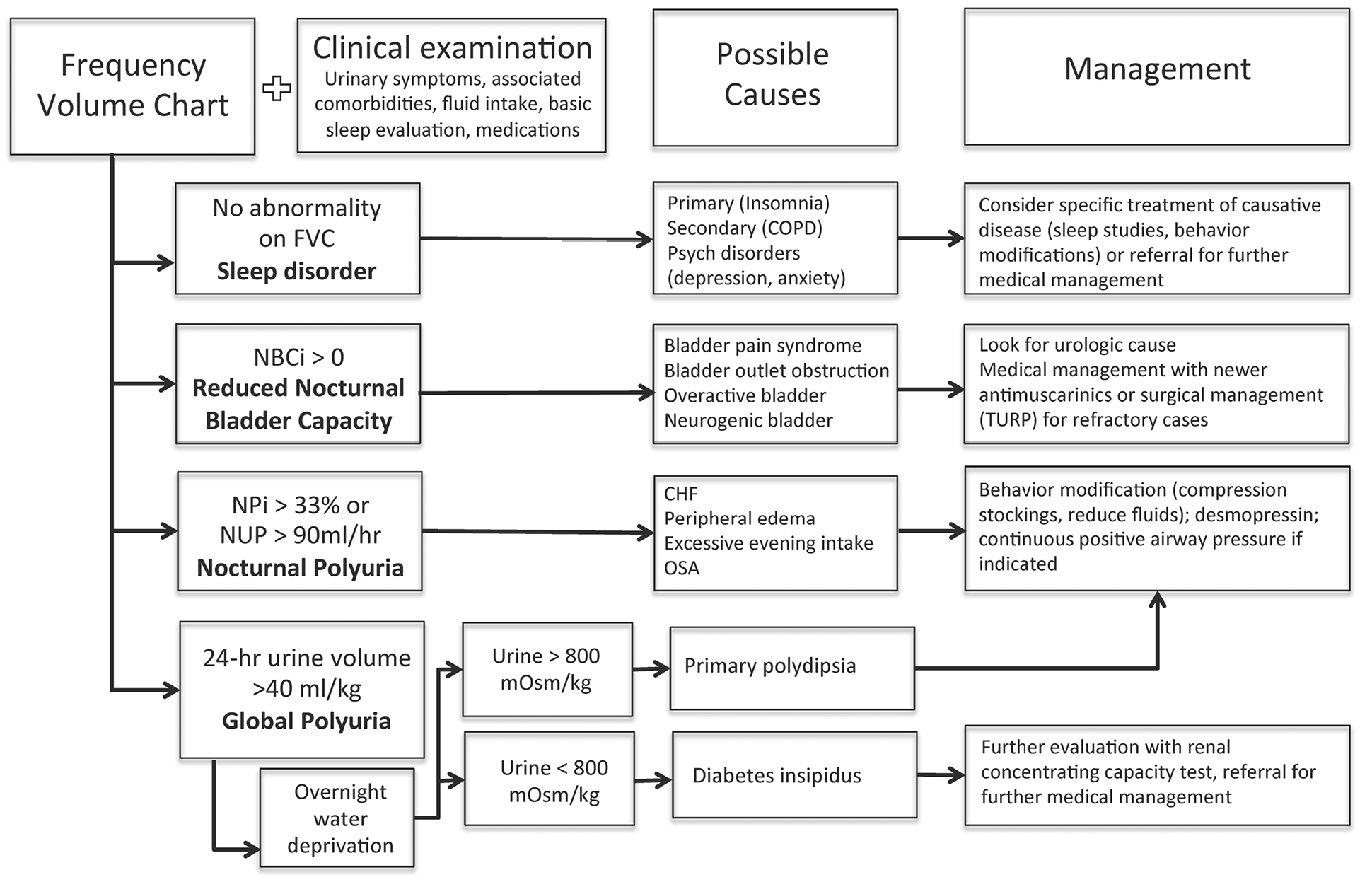Nocturia: an overview of evaluation and treatment

Objective: Nocturia is a highly prevalent and bothersome condition. It is associated with multiple medical comorbidities and an increased mortality. Recent investigations have improved understanding of nocturia and its evaluation and treatment. This paper aims to review the classification, etiology, associated medical conditions, evaluation, and treatment of nocturia.
Materials and Methods: A review was conducted surveying published clinical trials, meta-analyses and current clinical practice guidelines on nocturia available as of July 2014. Epidemiology, presentation, evaluation, and treatment recommendations are presented.
Results: Nocturia is a multifactorial condition. Evaluation should include thorough medical history documenting fluid intake, quantified and timed urine output, as well as signs and symptoms of other comorbid conditions. Thorough physical Exam should focus upon detection of conditions contributing to nocturia. Treatment should consist of optimization of underlying medical conditions, behavioral modifications, followed by medications if conservative management fails. Antimuscarinics and alpha blockers have not demonstrated to be effective. Recent studies indicate a possible role of desmopressin in the treatment of nocturia, but concerns about hyponatremia in older patients remain.
Conclusions: Nocturia is a bothersome condition. Treatment of associated co-morbidities is central to treatment. Currently available treatments are available, but efficacy is limited.
INTRODUCTION
Epidemiology

Etiology
Associated medical comorbidities
Evaluation
Management
Conclusions
- van Kerrebroeck P, Abrams P, Chaikin D, Donovan J, Fonda D, et al. (2002) The standardisation of terminology in nocturia: report from the Standardisation Sub-committee of the International Continence Society. Neurourol Urodyn 21: 179-183. [PubMed] [Google Scholar]
- Tikkinen KAO, Johnson 2nd TM, Tammela TLJ, Sintonen H, Haukka J, et al. (2009) Nocturia frequency, bother, and quality of life: how often is too often? A population-based study in Finland. Eur Urol 57: 488-496. doi: https://doi.org/10.1016/j.eururo.2009.03.080. [View Article] [PubMed] [Google Scholar]
- Van Dijk MM, Wijkstra H, Debruyne FM, De La Rosette, J.M.C.H. (Jean) , Michel MC (2010) The role of nocturia in the quality of life of men with lower urinary tract symptoms. BJU Int 105: 1141-1146. [PubMed] [Google Scholar]
- Tikkinen KAO, Auvinen A, Johnson 2nd TM, Weiss JP, Keränen T, et al. (2009) A systematic evaluation of factors associated with nocturia--the population-based FINNO study. Am J Epidemiol 170: 361-368. doi: https://doi.org/10.1093/aje/kwp133. [View Article] [PubMed] [Google Scholar]
- Tikkinen KAO, Tammela TLJ, Huhtala H, Auvinen A (2006) Is nocturia equally common among men and women? A population based study in Finland. J Urol 175: 596-600. doi: https://doi.org/10.1016/S0022-5347(05)00245-4. [View Article] [PubMed] [Google Scholar]
- Malmsten UG, Milsom I, Molander U, Norlén LJ (1997) Urinary incontinence and lower urinary tract symptoms: an epidemiological study of men aged 45 to 99 years. J Urol 158: 1733-1737. [PubMed] [Google Scholar]
- Bosch JL, Weiss JP (2013) The prevalence and causes of nocturia. J Urol 189: 86-92. doi: https://doi.org/10.1016/j.juro.2012.11.033. [View Article] [PubMed] [Google Scholar]
- Fitzgerald MP, Litman HJ, Link CL, McKinlay JB (2007) Investigators BS (2007) The association of nocturia with cardiac disease, diabetes, body mass index, age and diuretic use: results from the BACH survey. J Urol 177: 1385-1389. doi: https://doi.org/10.1016/j.juro.2006.11.057. [View Article] [PubMed] [Google Scholar]
- Weiss JP, Weinberg AC, Blaivas JG (2008) New aspects of the classification of nocturia. Curr Urol Rep 9: 362-367. [PubMed] [Google Scholar]
- Van_Doorn B, Kok ET, Blanker MH, Westers P, Ruud (2013) Bosch JL (2014) Determinants of nocturia. the Krimpen Study. J Urol 191: 1034-1039. doi: https://doi.org/10.1016/j.juro.2013.10.105. [View Article] [PubMed] [Google Scholar]
- Andersson KE, Nomiya M, Sawada N, Yamaguchi O (2014) Pharmacological treatment of chronic pelvic ischemia. Ther Adv Urol 6: 105-14. doi: https://doi.org/10.1177/1756287214526768. [View Article] [PubMed] [Google Scholar]
- Sakakibara R, Panicker J, Fowler CJ, Tateno F, Kishi M, et al. (2014) Is overactive bladder a brain disease? The pathophysiological role of cerebral white matter in the elderly. Int J Urol 2014: 21-1. doi: https://doi.org/10.1111/iju.12288. [View Article] [PubMed] [Google Scholar]
- Zeitzer JM, Bliwise DL, Hernandez B, Friedman L, Yesavage JA (2013) Nocturia compounds nocturnal wakefulness in older individuals with insomnia. J Clin Sleep Med 9: 259-262. doi: https://doi.org/10.5664/jcsm.2492. [View Article] [PubMed] [Google Scholar]
- Fitzgerald MP, Litman HJ, Link CL, McKinlay JB, Bach (2007) Survey Investigators (2007) The Association of Nocturia with Cardiac Disease. Diabetes, Body Mass Index, Age, Diuretic Use: Results from the BACH survey. J Urol 177: 1385-1389. doi: https://doi.org/10.1016/j.juro.2006.11.057. [View Article] [PubMed] [Google Scholar]
- Yoshimura K, Terada N, Matsui Y, Terai A, Kinukawa N, et al. (2004) Prevalence of and risk factors for nocturia: Analysis of a health screening program. Int J Urol 11: 282-287. doi: https://doi.org/10.1111/j.1442-2042.2004.00791.x. [View Article] [PubMed] [Google Scholar]
- Hirayama A, Torimoto K, Mastusita C, Okamoto N, Morikawa M, et al. (2012) Evaluation of factors influencing the natural history of nocturia in elderly subjects: results of the Fujiwara-kyo Study. J Urol 189: 980-986. doi: https://doi.org/10.1016/j.juro.2012.09.118. [View Article] [PubMed] [Google Scholar]
- Tandeter H, Gendler S, Dreiher J. Tarasiuk A (2011) Nocturic episodes in patients with benign prostatic enlargement may suggest the presence of obstructive sleep apnea. J Am Board Fam Med 24: 146-151. doi: https://doi.org/10.3122/jabfm.2011.02.100110. [View Article] [PubMed] [Google Scholar]
- Margel D, Shochat T, Getzler O, Livne PM, Pillar G (2006) Continuous positive airway pressure reduces nocturia in patients with obstructive sleep apnea. Urology 67: 974-977. doi: https://doi.org/10.1016/j.urology.2005.11.054. [View Article] [PubMed] [Google Scholar]
- TaKoskimäki J, Shiri R, Tammela T, Häkkinen J, Hakama M (2008) Depressive symptoms increase the incidence of nocturia: Tempere Aging Male Urologic. J Urol 179: 1897-901. doi: https://doi.org/10.1016/j.juro.2008.01.037. [View Article] [PubMed] [Google Scholar]
- Kupelian V, Fitzgerald MP, Kaplan SA, Norgaard JP, Chiu GR, et al. (2010) Association of nocturia and mortality: results from the Third National Health and Nutrition Examination Survey. J Urol 185: 571-577. doi: https://doi.org/10.1016/j.juro.2010.09.108. [View Article] [PubMed] [Google Scholar]
- Johnson TM, Endeshaw Y, Nagamia Z (2005) A multicomponent intervention for nocturia in men. J Am Geriatr Soc 104: 53-94. doi: https://doi.org/10.1111/j.1464-410X.2009.08353.x. [View Article] [PubMed] [Google Scholar]
- Cho SY, Lee SL, Kim IS, Koo DH, Kim H, et al. (2011) Short-term effects of systematized behavioral modification program for nocturia: a prospective study. Neurourol Urodyn 31: 64-68. doi: https://doi.org/10.1002/nau.21186. [View Article] [PubMed] [Google Scholar]
- Johnson 2nd TM, Jones K, Williford WO, Kutner MH, Issa MM, et al. (2003) Changes in nocturia from medical treatment of benign prostatic hyperplasia: secondary analysis of the Department of Veterans Affairs Cooperative Study Trial. J Urol 170: 145-148. doi: https://doi.org/10.1097/01.ju.0000069827.09120.79. [View Article] [PubMed] [Google Scholar]
- Johnson 2nd TM, Burrows PK, Kusek JW, Nyberg LM, Tenover JL, et al. (2007) The effect of doxazosin, finasteride and combination therapy on nocturia in men with benign prostatic hyperplasia. J Urol 178: 2045-2050. doi: https://doi.org/10.1016/j.juro.2007.07.013. [View Article] [PubMed] [Google Scholar]
- Johnson 2nd TM, Burgio KL, Redden DT, Wright KC, Goode PS (2005) Effects of behavioral and drug therapy on nocturia in older incontinent women. J Am Geriatr Soc 53: 846-850. doi: https://doi.org/10.1111/j.1532-5415.2005.53260.x. [View Article] [PubMed] [Google Scholar]
- Yokoyama O, Yamaguchi O, Kakizaki H, Itoh N, Yokota T, et al. (2011) Efficacy of solifenacin on nocturia in Japanese patients with overactive bladder: impact on sleep evaluated by bladder diary. J Urol 186: 170-174. doi: https://doi.org/10.1016/j.juro.2011.02.2700. [View Article] [PubMed] [Google Scholar]
- Rackley R, Weiss JP, Rovner ES, Wang JT, Guan Z (2006) Nighttime dosing with tolterodine reduces overactive bladder-related nocturnal micturitions in patients with overactive bladder and nocturia. Urology 67: 731-736. doi: https://doi.org/10.1016/j.urology.2005.10.061. [View Article] [PubMed] [Google Scholar]
- Weiss JP, Jumadilova Z, Johnson 2nd TM, Fitzgerald MP, Carlsson M, et al. (2012) Efficacy and safety of flexible dose fesoterodine in men and women with overactive bladder symptoms including nocturnal urinary urgency. J Urol 189: 1396-1401. doi: https://doi.org/10.1016/j.juro.2012.11.067. [View Article] [PubMed] [Google Scholar]
- Moon DG, Jin MH, Lee JG, Kim JJ, Kim MG, et al. (2004) Antidiuretic hormone in elderly male patients with severe nocturia: a circadian study. BJU Int 94: 571-575. doi: https://doi.org/10.1111/j.1464-410X.2004.05003.x. [View Article] [PubMed] [Google Scholar]
- van Kerrebroeck P, Rezapour M, Cortesse A, Thüroff J, Riis A, et al. (2007) Desmopressin in the treatment of nocturia: a double-blind, placebo-controlled study. Eur Urol 52: 221-229. doi: https://doi.org/10.1016/j.eururo.2007.01.027. [View Article] [PubMed] [Google Scholar]
- Juul KV, Klein BM, Norgaard (2012) JP (2013) Long-term durability of the response to desmopressin in female and male nocturia patients. Neurourol Urodyn 32: 363-370. doi: https://doi.org/10.1002/nau.22306. [View Article] [PubMed] [Google Scholar]
- Weatherall M (2004) The risk of hyponatremia in older adults using desmopressin for nocturia: a systematic review and meta-analysis. Neurourol Urodyn 23: 302-305. doi: https://doi.org/10.1002/nau.20038. [View Article] [PubMed] [Google Scholar]
- Song M, Hong BS, Chun J, Han J, Choo M (2014) Safety and efficacy of desmopressin for the treatment of nocturia in elderly patients: a cohort study. Int Urol Nephrol 46: 1495-1499. doi: https://doi.org/10.1007/s11255-014-0679-0. [View Article] [PubMed] [Google Scholar]
- Simaioforidis V, Papatsoris AG, Chrisofos M, Chrisafis M, Koritsiadis S, et al. (2011) Tamsulosin versus transurethral resection of the prostate: effect on nocturia as a result of benign prostatic hyperplasia. Int J Urol 18: 243-248. doi: https://doi.org/10.1111/j.1442-2042.2010.02704.x. [View Article] [PubMed] [Google Scholar]

